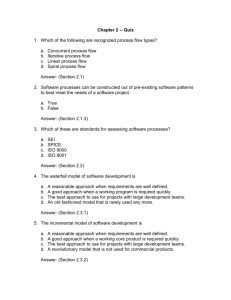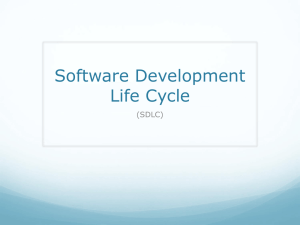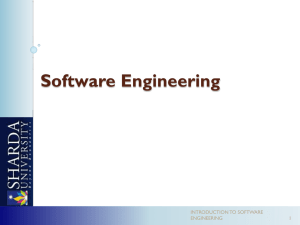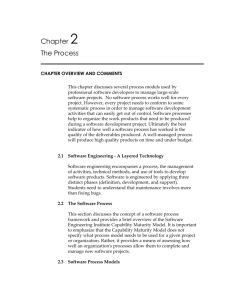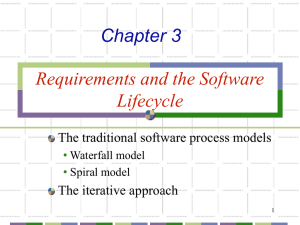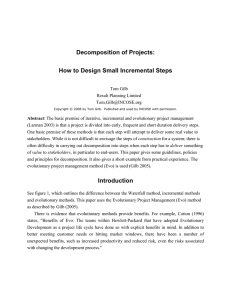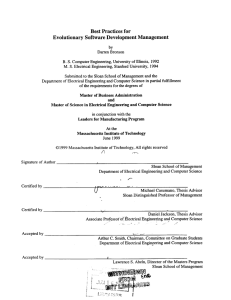The Spiral Model and Risks
advertisement
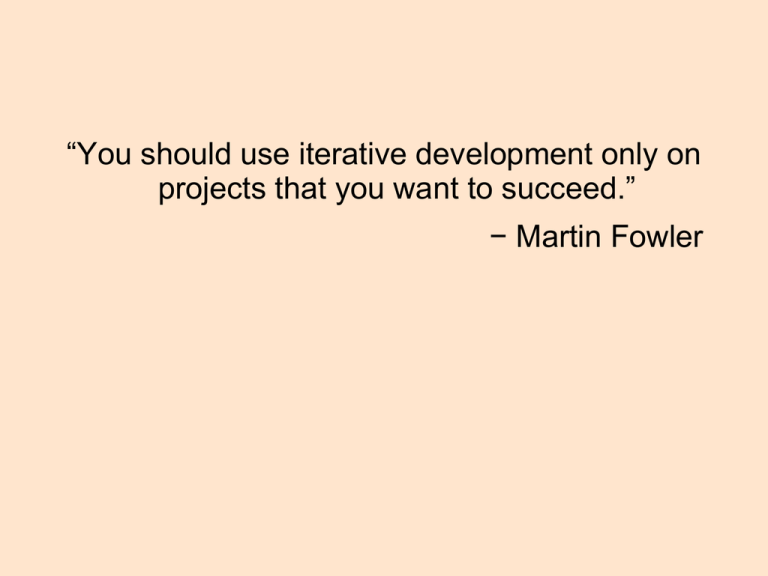
“You should use iterative development only on projects that you want to succeed.” − Martin Fowler Barry W. Boehm, “A Spiral Model of Software Development and Enhancement”. Computer 21(5), pp. 61-72, May 1988 Prof. Software engineering, Univ. Southern California Worked at General Dynamics, Rand, TRW Director of DARPA Information Science and Technology Office 1989-1992 Fellow of ACM, IEEE COCOMO cost model, Spiral model, ... The Basic Force Code-driven development “Code-and-fix” approach No design leads to poor code and frustrated clients Document-driven development Waterfall model: each step produces a new document Requirement for fully developed documents unrealistic Risk-driven development Support iterative development Decide how to proceed by reducing risk of failure The Spiral Model Several rounds of development: system concept, requirements, design In each round, mitigate risks Define objectives of part you are doing Map alternatives for implementation Recognize constraints on theseWhat alternatives you actually depends on Use prototyping, analysis, etc. todo gain necessary the biggest knowledge and reduce risk remaining risk Plan the next step At the end, perform sequence of coding, testing, and integration Using the Spiral Start with hypothesis that something can be done Round 1: concept and lifecycle plan Round 2: top level requirements Additional rounds: preliminary design, detailed design May go back and redo previous round if needed If the evaluation at some stage shows that it won't work then stop At the end you have a workable design that addresses all risks – go on to coding Risks Developing software is fraught with uncertainty Uncertainty implies risk This needs to be quantified: RiskExposure = Probability x Loss Can be used to chose between alternatives: select the one where the expected exposure is smaller Barry W. Boehm, “Software Risk Management: Principles and Practices”. IEEE Software 8(1), pp. 32-41, Jan 1991 Risk Management identification assessment what can go wrong checklists, verify assumptions analysis how, implications (cost models) prioritization based on exposure Risk management planning avoid or reduce (spiral) resolution control find appropriate alternatives prototypes, analysis, simulation monitoring (top 10) fixed issues stay fixed Milestones In waterfall model there are many milestones This is too rigid and sequential Make sure we know what we want But there are three really important ones: Elaborate to do, and thatonit Life-cycle objectives Prepare forwill the how things can be done transition be builtto the Life-cycle architecture client in terms of Initial operational capability site and training (these foreshadow the unified process) Barry W. Boehm, “Anchoring the Software Process”. IEEE Software 13(4), pp. 73-82, Jul 1996 Milestones Milestones are not (necessarily) documents! Not a fully specified spec or architecture, but a framework that will evolve For example, important interfaces must be specified precisely, but user interfaces can be a prototype Articulation of feasibility and rationale are important Agreement of stakeholders is crucial Tom Gilb Principles of Software Engineering Management Addison Wesley, 1988 Born in the USA Moved to UK to study Fell in love, moved to Norway Worked for IBM for 5 years Independent consultant with son Kai www.gilb.com EVO • Short for Evolutionary Delivery, chapters 7 and 13 in the book • “Arguably the best systems engineering project management method. However, it is also probably the least known and the least discussed” • Core idea: Deliver value to stakeholders early and often EVO • Iterative and incremental • Deliver in small parts, instead of big bang at the end (note: not only develop in parts, but actually deliver) EVO • Iterative and incremental • Deliver in small parts, instead of big bang at the end (note: not only develop in parts, but actually deliver) • Each iteration is like a waterfall • Analysis, design, build, test • Small scope and fast turnaround • Each iteration must give customer some value • Prioritize according to maximal value for minimal cost • Don’t over-plan EVO The Norwegian mountain survival principle: You need never be ashamed of turning back in time The juicy bits first principle: If you deliver the juiciest bits of the project first, they will forgive cost and budget overruns The mountain goat principle: Take one step at a time up the slippery mountain, and make sure each hoof is on solid ground first Prioritization 1. Divide functions into “urgently needed”, “needed soon”, and “needed later” 2. Divide urgent functions into high/low political value and high/low economic value 3. Divide high-value functions into low/high implementation cost 4. Divide low-cost functions into fast implementation or slower implementation 5. Divide fast implementation into low/high risk of failure 6. Implement low-risk, fast, low-cost, high-value, urgent function 7. Repeat, monitoring and learning from mistakes Planning • Need a general idea of where you want to go • But not a detailed plan for the whole way • inflexible • Wasted effort • Analogy of road trip from London to Rome • At each step, plan only that step Contracts • Conventionally pay for work • Millions of dollars paid for work that led to failure • No incentive to deliver working software • “No cure no pay” • Pay for delivered functionality • Incremental payments match incremental development • Incentive to produce working software Additional Emphases • Don’t forget non-functional requirements • Quality attributes such as performance • Resource attributes such as storage space • Providing this can be more costly than the basic functionality • Everything can and should be quantified • Break it down into components • Find the relevant scale for each one Example: Ease of Access Perspective • What projects can benefit from EVO? Slide from presentation about NSA system leaked by Edward Snowden, 2013
